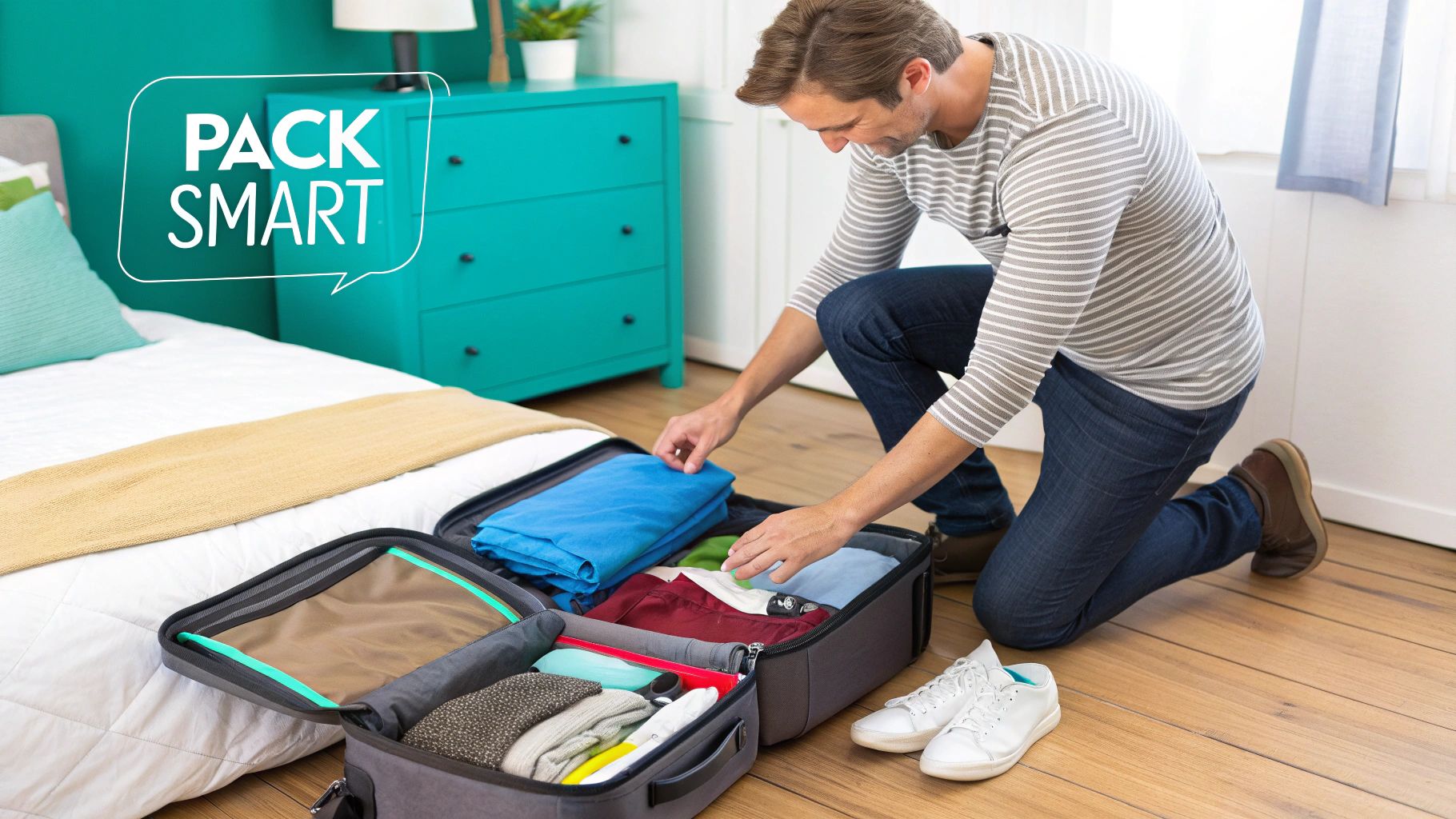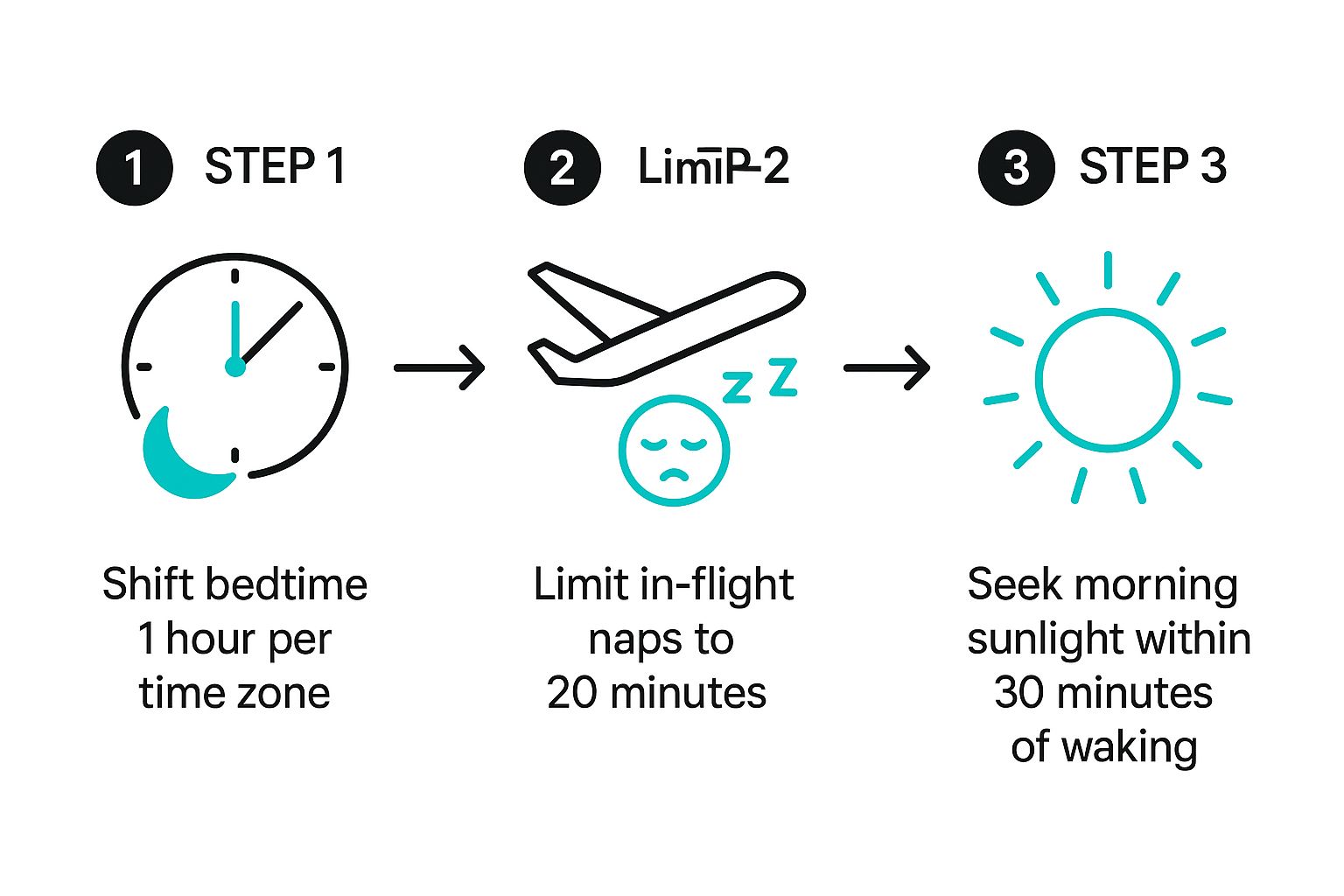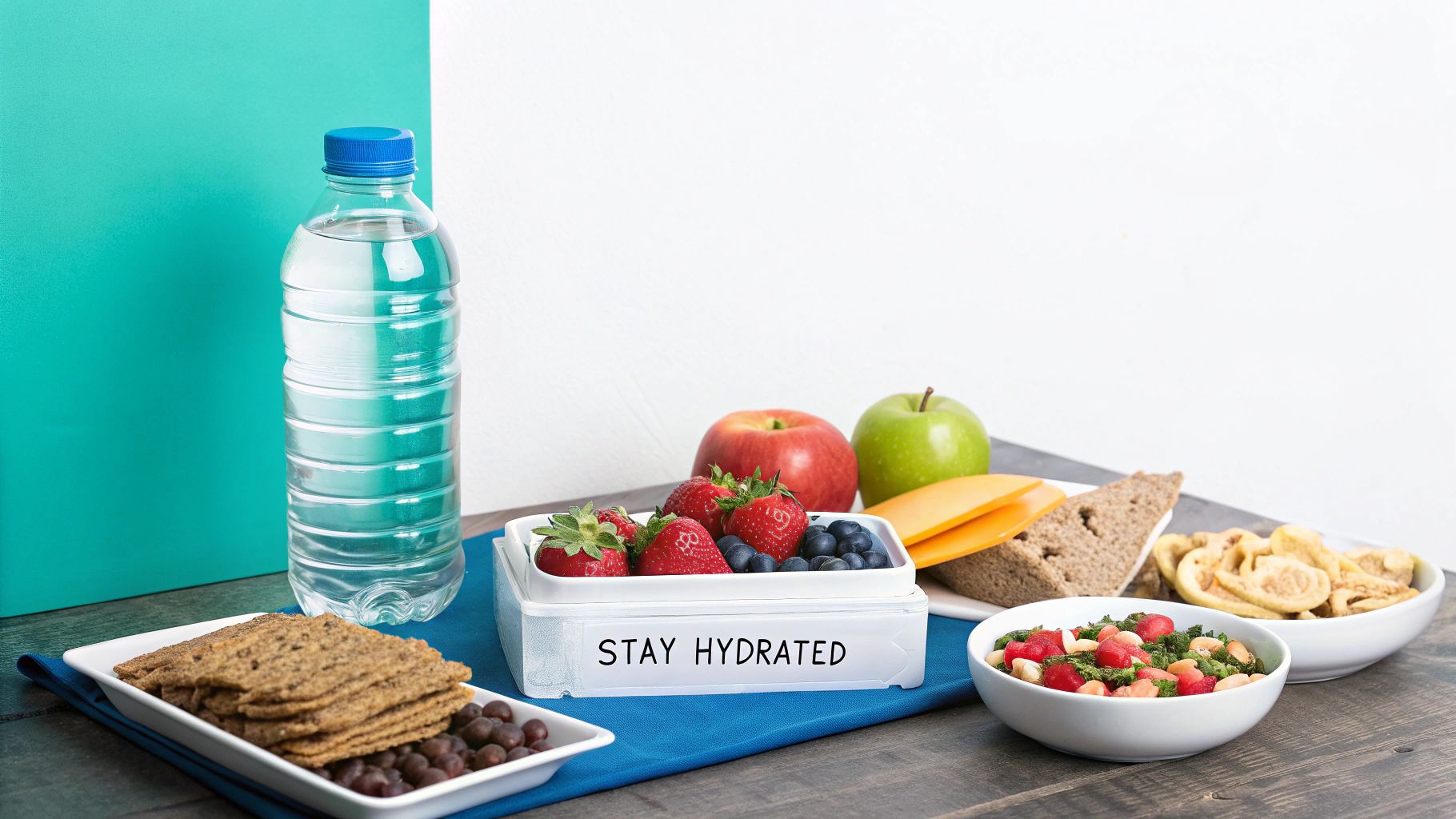

· By Annemarie
How to Recover from Jet Lag Fast: Proven Tips & Tricks
To really get a handle on jet lag, you first have to appreciate what a massive disruption it is to your entire system. It’s so much more than just feeling wiped out. It's a full-on physiological mismatch where your internal body clock—your circadian rhythm—is completely out of step with your new surroundings, messing with everything from your sleep to your appetite and even your mood.
Getting why this happens is the secret to finally conquering it.
Why Jet Lag Feels So Draining
Ever flown from New York to London and felt like you were in a fog for days, but the trip back home felt like a breeze? You're not imagining it. Jet lag is a legitimate medical condition called desynchronosis, and it happens when your body's natural 24-hour cycle gets completely thrown off.
Think of your internal clock as a master regulator. It’s in charge of your sleep-wake cycle, hormone production, body temperature, and even your digestion. When you zip across multiple time zones in just a few hours, your body is still stubbornly running on its old schedule. It might be prime lunchtime in Paris, but your stomach is convinced it’s 6 AM and has zero interest in that croissant.
The East vs. West Battle
Believe it or not, the direction you fly makes a huge difference in how you feel. For most of us, flying east is a much tougher beast to tame than flying west. But why? Flying east means your day gets shorter, forcing you to try and sleep before your body is ready—a much harder adjustment to make.
As a rule of thumb, it’s always easier for your body to delay sleep (staying up later) than it is to advance it (going to bed earlier). That's what makes traveling west, where you "gain" time, a much smoother ride.
This isn't just a feeling; there's some solid science behind this lopsided recovery. Research has found that after an eastward flight, our internal clock can only manage to shift forward by about 57 minutes per day. But when we fly west, it can delay itself by a much more forgiving 92 minutes daily. This makes the adjustment period feel way faster.
That means a six-hour time difference could genuinely take you longer to recover from when flying east compared to west. If you're a science nerd, you can dive into the full study on this circadian clock asymmetry.
This is why you feel so groggy, irritable, and why your stomach might feel off. You’re not just tired—your entire system is scrambling to catch up to a brand new reality. Understanding this internal struggle is the first step in putting together a smart recovery plan that actually works.
Prepare Your Body Before You Depart

If you ask me, a good trip starts days before you even lock your front door. Beating jet lag isn’t something you do after you land; it’s a game you win before you even take off. Giving your body a gentle nudge toward your destination's time zone can make a world of difference in how you feel when you get there.
It’s all about easing your internal clock into the new schedule. Let's say you're flying east, where you'll need to wake up earlier. For a few days before you leave, try going to bed and waking up 30 to 60 minutes earlier each day. Trust me, this gradual shift is so much easier on your system than the abrupt shock of a huge time change.
Strategic Flight and Hydration Choices
A few smart choices in the days leading up to your flight can be a total game-changer. First, hydration is non-negotiable. The air inside an airplane cabin is notoriously dry and will dehydrate you in a heartbeat, which makes every symptom of jet lag feel ten times worse. I always start chugging extra water a day or two before I even think about heading to the airport.
Also, think about your arrival time when you book your flight. I always aim for flights that land in the early evening. It’s the perfect setup: you can grab a light dinner, head to your hotel, and get to bed at a normal local time. This little trick helps you sync up from the very first night.
Pro Tip: Your prep goes beyond just drinking water. I always pack a small "jet lag kit" in my carry-on with an eye mask, earplugs, and my trusty refillable water bottle. Being comfortable and prepared is half the battle.
Assemble Your Carry-On Jet Lag Kit
Having the right gear within arm's reach on the plane can make all the difference between a miserable flight and a restful one. Your goal here is to control your environment—specifically light and noise—to help your brain get the message that it’s time to rest. For a full rundown of what to pack and other ways to stay healthy on your trip, check out these essential travel health tips.
Here’s what I never fly without in my kit:
- An eye mask and earplugs: These are critical for blocking out cabin lights and engine noise. It’s the universal signal to your brain to power down, even if the sun is blazing outside your window.
- A comfortable neck pillow: Don’t underestimate the power of a good neck pillow. It's the key to getting some actual quality sleep without waking up with a sore neck.
- Healthy, light snacks: Skip the heavy, salty airline food that can make you feel sluggish. Packing your own snacks keeps your energy levels stable and your stomach happy.
Master Your New Time Zone Upon Arrival
The moment your plane touches down, the real work begins. Those first 24 hours are absolutely critical for convincing your body it’s time to get with the program. Your mission, should you choose to accept it, is to sync up with local time—and that means living on the new schedule immediately, no matter how much your body is screaming for sleep.
If you land during the daytime, you’ll likely face your biggest challenge right away: the overwhelming urge to crash. Don't do it. A long nap can completely sabotage your adjustment and make it that much harder to fall asleep later that night.
Instead, you have to force yourself to get moving. Take a walk and explore your new surroundings, find a local cafe for a coffee (just not too late in the day!), or simply get outside. The idea is to stay active and engaged until a reasonable local bedtime rolls around.
Harness the Power of Light
Your most powerful tool in this fight is natural light. Seriously. Sunlight is the number one signal that tells your brain to be awake and alert, and it's what will ultimately reset your internal clock, or circadian rhythm.
But how you use light depends entirely on which direction you’ve flown. It’s all about timing your exposure to either push your body clock forward or hold it back.
Getting outside for at least 30 minutes within the first hour of waking up in your new time zone can make a huge difference. That blast of morning light sends a strong "wake up!" signal right to your brain, speeding up the whole process.
This simple infographic breaks down the key principles for a smoother adjustment, covering everything from pre-flight prep to what to do after you land.

As the visual shows, a good recovery strategy has a few moving parts, but strategic light exposure is the final, crucial step once you’ve arrived. To help you nail the timing, here’s a quick guide.
Light Exposure Guide for Jet Lag Recovery
Use this table to time your light exposure based on your direction of travel to speed up circadian rhythm adjustment.
| Direction of Travel | Best Time for Morning Light Exposure | When to Avoid Bright Light |
|---|---|---|
| Traveling East (e.g., USA to Europe) | Seek bright light as soon as you wake up. | Avoid bright light in the late afternoon/evening. |
| Traveling West (e.g., Europe to USA) | Avoid bright light first thing in the morning. | Seek out plenty of late afternoon/early evening sun. |
Remember, when you fly east, you're trying to advance your body clock (wake up earlier), so morning light is your friend. When you fly west, you need to delay your clock (stay up later), so afternoon light is what you need.
Getting these first few actions right sets the stage for a much faster return to feeling 100%. For a deeper dive into other helpful strategies, check out our guide on natural remedies for jet lag.
Optimize Your Sleep Environment for Faster Recovery

Managing your daytime schedule is just one piece of the puzzle. To really beat jet lag, getting quality, restorative sleep at night is completely non-negotiable. This is especially true when you’re trying to crash in an unfamiliar hotel room.
The struggle is particularly real after flying east. I was floored when I saw the research on this: a massive study analyzing 1.5 million nights of sleep found that long eastward trips can slash total sleep time by an average of 62 minutes on the first night. It's not just about less sleep, either—this kind of travel messes with your deep and REM sleep, leaving you feeling groggy even if you were in bed for hours.
Your mission, should you choose to accept it, is to transform your temporary room into a sleep sanctuary. Think cool, dark, and quiet.
Create Your Personal Sleep Cave
Even the nicest hotels have their quirks—that annoying sliver of light under the door, the surprisingly loud ice machine down the hall. Don't leave your sleep up to chance.
- Block every last photon. Use those blackout curtains, but don't stop there. I always grab the clips on the clothes hangers to pinch the gap in the middle shut. A rolled-up towel at the base of the door works wonders for blocking hallway light.
- Keep it chilly. A room temperature between 60-67°F (15-19°C) is the sweet spot for sleep. Don't be afraid to crank that hotel AC down.
- Drown out the noise. If you're a light sleeper like me, a white noise app on your phone or a travel-sized sound machine is an absolute lifesaver. It’s perfect for masking those unpredictable bumps in the night.
It's a common mistake to lump all "sleep aids" together. Some habits can seriously backfire and disrupt your sleep—much like alcohol does—while others can genuinely help reset your body clock.
Take melatonin, for instance. A small dose of 0.5 to 3 milligrams about 30 minutes before your new local bedtime can be a game-changer. It's not about knocking yourself out; it's about sending a gentle signal to your brain that it's time to wind down, helping you nudge your internal clock in the right direction. For a deeper dive into common sleep disruptors, check out our guide on how to sleep better after drinking.
Smart Lifestyle Habits That Speed Up Adjustment
While sorting out your light exposure and sleep schedule are the big-ticket items, don't sleep on the smaller stuff. What you do during your waking hours—like what you eat, when you move your body, and how much water you're chugging—plays a huge supporting role in getting you back on track.
Think of it this way: aligning these daily habits with your new time zone sends constant, reinforcing signals to your entire system that it’s time to get with the program.
One of the easiest yet most powerful tricks is to sync your meals to the local clock right away. Your digestive system has its own internal clock, so eating when your body thinks it's the middle of the night can throw a wrench in things. If you land in Tokyo at 8 AM, you eat breakfast. It might feel weird forcing down a meal when your body is screaming for sleep, but it’s a surprisingly effective way to anchor yourself to the new day.
For the first day or two, try to keep your meals on the lighter side. Heavy, greasy foods can make you feel even more sluggish and put extra stress on a digestive system that's already completely out of whack.
And please, stay hydrated. This is a non-negotiable. The dry cabin air on a long flight is notorious for causing dehydration, which makes every single symptom of jet lag worse, from headaches to that deep, soul-crushing fatigue. Do yourself a favor and carry a water bottle everywhere, sipping throughout the day even when you don't feel thirsty.
Get Moving, but Time It Right
A little light exercise is another fantastic tool for reminding your body that it’s daytime. You don't need to run a marathon; a simple brisk walk or some stretching is enough to boost your energy, lift your mood, and help you power through that afternoon slump without giving in to a long nap that will only sabotage your progress later.
But when you exercise really matters.
- Flying East? Go for a morning workout. This helps nudge your body clock forward and pairs perfectly with that "wake up!" signal you’re getting from the morning sun.
- Flying West? An afternoon workout is your best bet. It helps you stay awake longer and delays your internal clock, making it much easier to adapt to a later bedtime.
These small, consistent habits might not seem like much on their own, but they work together to slash your recovery time. By lining up your meals, hydration, and activity with the local schedule, you give your body the clear, repeated cues it needs to adjust and finally feel human again.
Got Questions About Beating Jet Lag? We’ve Got Answers.

Even with a solid game plan, you're bound to have a few lingering questions. It’s totally normal. Trying to outsmart your body clock can feel like a guessing game, but having the right information makes all the difference.
Let's clear up some of the most common questions travelers ask about getting over jet lag. Think of this as your go-to FAQ for feeling human again after a long flight.
How Long Does Recovery Really Take?
You’ve probably heard the old rule of thumb: one day of recovery for every time zone you cross. So if you’re dealing with a six-hour time difference, you might feel a bit off for up to six days. But honestly, that's just a rough estimate, not a hard-and-fast rule.
Your personal recovery timeline is unique. It depends on which direction you flew, your overall health, and how well you stick to the new schedule. If you’re proactive about getting sunlight, timing your meals, and sleeping at the right times, you can slash that adjustment period significantly.
Are Sleeping Pills a Good Idea?
It's tempting to pop a sleeping pill when you're staring at the ceiling at 3 AM, but they usually cause more problems than they solve for jet lag. Prescription pills might knock you out, but they do nothing to reset your internal body clock—which is the real issue here. You often wake up feeling even groggier and more out of sync.
A much better approach is a supplement like melatonin. It’s not a sedative. Instead, it works with your body's natural rhythms, gently signaling to your brain that it's time to wind down for sleep.
Do Food and Drink Choices Matter?
They absolutely do. Your digestive system has its own internal clock, so getting it on local time is a big piece of the puzzle. Eating lighter meals that line up with your new destination’s schedule helps your whole body get on the same page, faster.
It’s also smart to be mindful of two major culprits:
- Caffeine: That morning cup of coffee is totally fine. Just skip any caffeine in the afternoon or evening. It can mess with your sleep schedule hours later when you're actually trying to rest.
- Alcohol: A drink might make you feel drowsy at first, but it seriously messes with the quality of your sleep later in the night. This fragmentation just slows down your body's ability to recover and adjust.
From cross-country flights to holiday toasts, keeping your body feeling its best is everything. Upside is a simple, effective way to embrace life's best moments without worrying about the next-day drag. It’s the perfect travel companion.
Learn more about how Upside can help you feel your best at https://enjoyupside.com.
